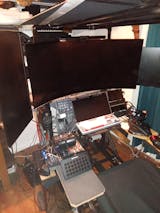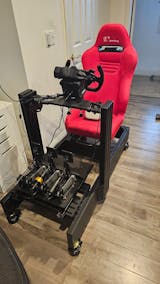
How Racing Simulators Are Changing the Future of Motorsports
Remember those arcade racing games we used to pump quarters into? Well, racing sims have come a long way since then. What used to be just a fun way to kill time has turned into serious business that's completely reshaping how people get into racing, how the pros train, and how fans experience the sport. The simulator market has exploded to a crazy $4.5 billion worldwide and is growing faster than a Tesla in Ludicrous mode (about 12% every year).
From Gaming Consoles to Pro Training Tools
It's wild to think about, but actual professional race car drivers are now spending almost as much time in simulators as they do in real cars. Max Verstappen – you know, the F1 champion – is famous for hopping on his simulator after actual race weekends. The guy just can't get enough!
Today's high-end simulators deliver force feedback that'll make your arms sore the next day. Premium options like the Simucube Ultimate wheel base can generate up to 32Nm of torque – that's enough to make you break a sweat during a long race. The responsiveness is insane too, with inputs being registered 1,000 times per second. When you feel the back end start to slide out in one of these setups, your brain and muscles are learning exactly what that feels like in real life.
Racing Without Breaking the Bank
Let's be real – traditional motorsport might as well have a sign that says "Rich People Only." A single weekend of amateur GT racing can easily cost more than a decent used car – we're talking $15,000-$20,000 when you add up entry fees, tires, fuel, and having a crew help you out.
That's where simulators come in and change the game completely. A top-notch setup from a company like Apevie might cost $5,000-$10,000. Sure, that's not pocket change, but it's a one-time purchase that's about the same as one race weekend. And unlike real racing, you're not constantly shelling out thousands for new tires or fixing crash damage (which can easily hit $30K for even minor stuff in some race classes).
This affordability has created this amazing pipeline of talent that wouldn't exist otherwise. Look at William Byron – dude went from racing online to winning actual NASCAR Cup races. That kind of story was impossible before simulators came along.
Crash All You Want – Just Hit Reset
One of the coolest things about simulator training is that you can push way beyond your comfort zone without any consequences. In a real race car, every time you try something risky, you're gambling with thousands of dollars and potentially your safety.
In a simulator with a high-quality setup like a Simucube wheel base, you can try that crazy late-braking move into Turn 1 at Laguna Seca a hundred times until you get it right. Crash spectacularly? Just hit reset and try again. No harm, no foul, no massive repair bill.
This is huge for learning new tracks too. Pro drivers can show up at circuits they've never physically visited before but already have hundreds of virtual laps under their belts.
Esports: It's the Real Deal Now
Sim racing isn't just practice anymore – its own thing with serious money and followings. The 2023 F1 Esports Series had a prize pool of $750,000 (not too shabby!) with viewers tuning in from 157 countries. During the pandemic when real racing was shut down, NASCAR's virtual racing series pulled in 1.3 million viewers for a single event. Many of those pro drivers were using top-tier equipment like the Simucube Ultimate in their home setups. That's more than a lot of "real" sports get!
The lines are getting super blurry between virtual and real racing. Sim racers are jumping into real cars, real drivers are competing seriously online, and fans are following both without making much distinction between them.
All About the Data
Maybe the most game-changing aspect of simulators is all the data they give you. Every tiny input – when you brake, how much throttle you apply, your exact steering angle – gets recorded and can be analyzed down to the millisecond.
Instead of just feeling like you're slow in a certain corner, you can see exactly where you're losing time and experiment with different approaches. Companies like Apevie build setups that give you this kind of precision feedback that used to be available only to top-tier racing teams with massive budgets.
The Future Is Now
As this tech keeps getting better, the gap between virtual and real racing will just keep shrinking. The feel will get more realistic, the visuals more immersive, and the physics even more accurate.
For motorsport as a whole, this means fresh talent constantly bubbling up, better training for everyone from rookies to veterans, and fans who understand the sport at a much deeper level because they've experienced it themselves virtually.
Whether you're a weekend warrior looking to sharpen your skills, a total newbie curious about getting into racing, or just someone who loves the thrill of pushing a car to its limits, today's simulators offer an experience that was straight-up science fiction just ten years ago.
Companies like Apevie are right in the middle of this revolution, making it possible for regular people to experience what used to be reserved for the racing elite.



